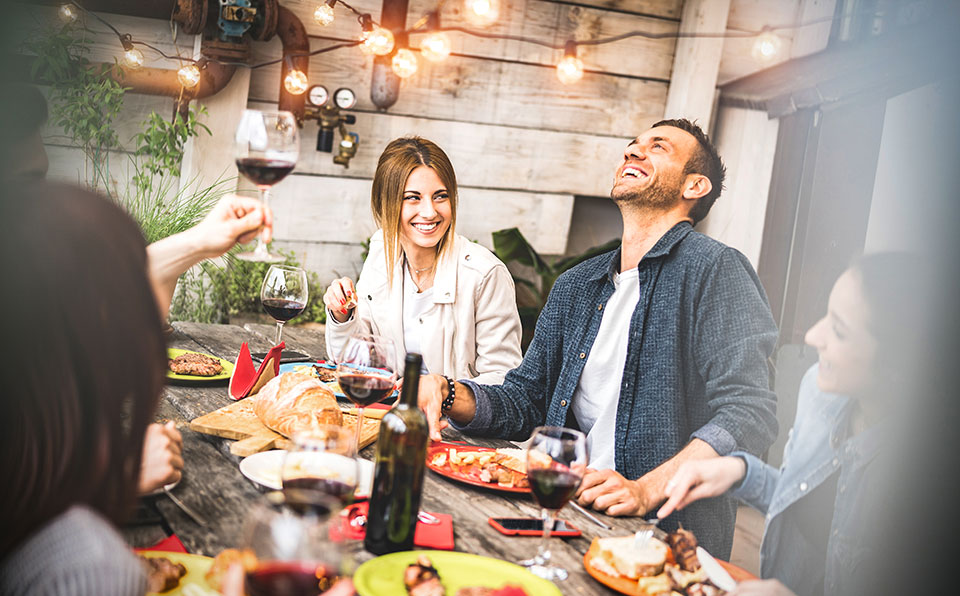The Reason for the Season
by Cassidy Mantor
In some towns, springtime is the invitation to emerge from the winter’s hibernation and venture back outside again. That couldn’t be farther from the truth for this town. In Bend, people live outside all year round. It’s like the saying that there’s no bad weather, just improper clothing. In Central Oregon, a fire pit or outdoor fireplace is the equivalent of a good puffy jacket. You need at least one to enjoy the winter.
Outdoor living in Bend might start with the idea of sitting around a fire pit during ski season, but it expands into summer with BBQs and entertaining after a good day on the river or a great time on the trails. Whether your idea of outdoor living includes a tennis court, a yoga oasis, or a handcrafted treehouse for the grandkids, the stories that follow will have you thinking of how to design your dream outdoor living space. Read more to learn about:
Fire pits & fireplaces from Homeland Design
Destination outdoor spaces, sports courts, & kitchens from Winsome Construction
One-of-a-kind hand-forged Plancha cookers, fire pits, & fire tools from custom blacksmith Orion Forge
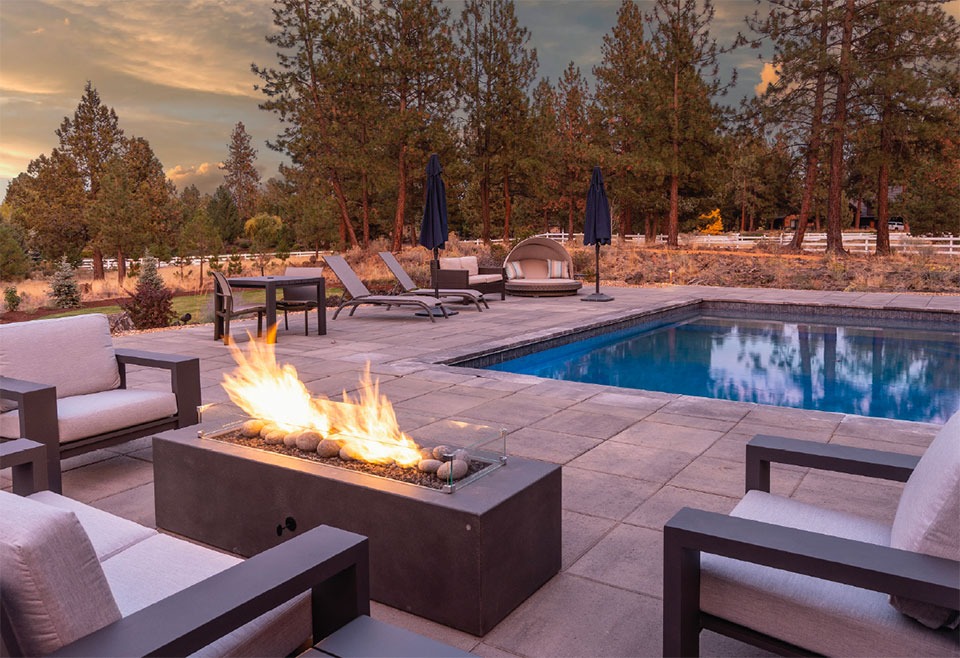
Rooted in Central Oregon
Landscape Design by Homeland Design
Becky Shaw is a fifth-generation Central Oregonian who considers herself lucky to have grown up understanding the value of outdoor living. She knows people build in Bend for the lifestyle – for those 300 days of sunshine, for those late nights under the stars around the backyard fire pit, and for the family holiday gatherings when no one leaves the kitchen. Becky’s appreciation for the place where she grew up led her to go back to school to focus on landscape design, one of the services offered by Homeland Design. “I wanted to be outside working with plants,” Becky explains. Together with her husband Joey, an architectural designer, they offer clients a holistic approach to site and house design.
Working through Architectural Review
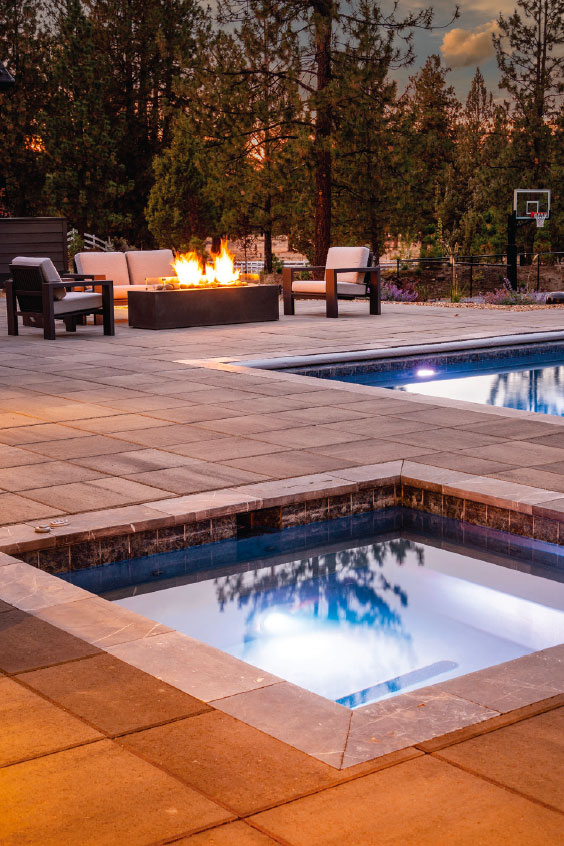
Building a lifestyle in Central Oregon is about embracing the freedom to play outside, but what happens when the neighbors don’t approve? When the pandemic started, Homeland began working on a project for a family that wanted to include a sports court in their backyard as well as a spa and pool for healthier outdoor living. The family had two young children and they wanted their children to be able to play on the court while watching them from the back deck. The neighbors, however, did not want to see any of it.
“We worked with the neighborhood review committee and a pool contractor to create a good flow that looked beautiful too,” Becky shares. “We had to screen the sports court from the neighboring houses so we built up a five-foot-tall berm on the sides loaded with trees to hide it. Our goal was to have the space function well and also be attractive and complement the home’s architecture. We preserved mature Ponderosa pine trees and also made a fire-safe space that would entertain the family and also be safe.”
Around the fire pit, Becky incorporated large-format paver slabs for a clean and open feel. The natural stone slab steps complement the brown gravel they used. “That landscaping stone is great for Central Oregon because it doesn’t have to be replaced and is not going to catch fire,” she notes. Becky is now completing add-ons that will enhance the family’s enjoyment of their home that much more.
“That landscaping stone is great for Central Oregon because it doesn’t have to be replaced and is not going to catch fire.”
–Becky Shaw, Homeland Design
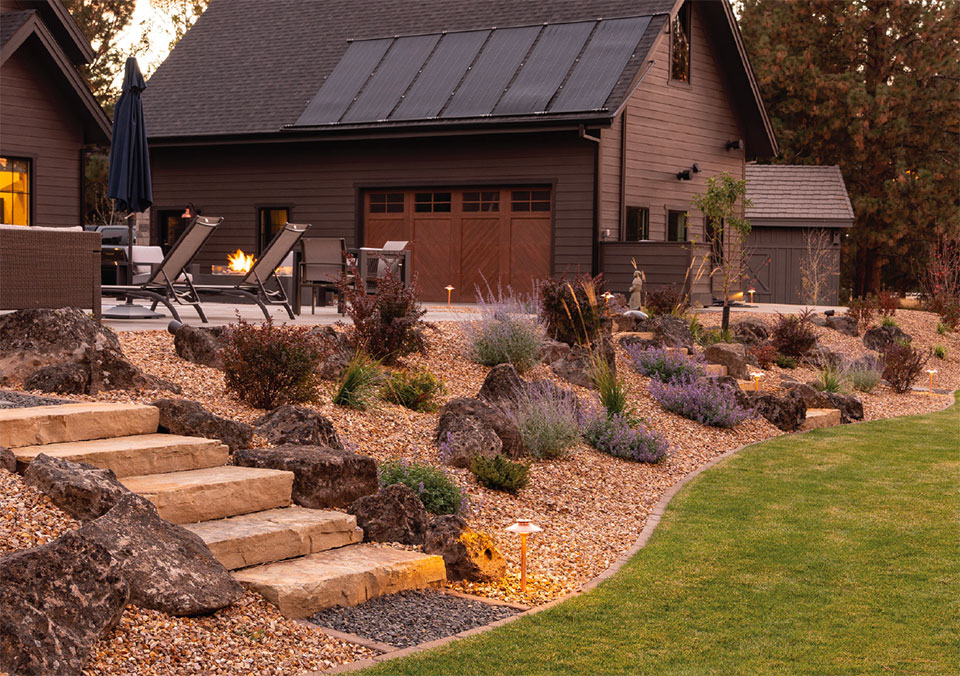
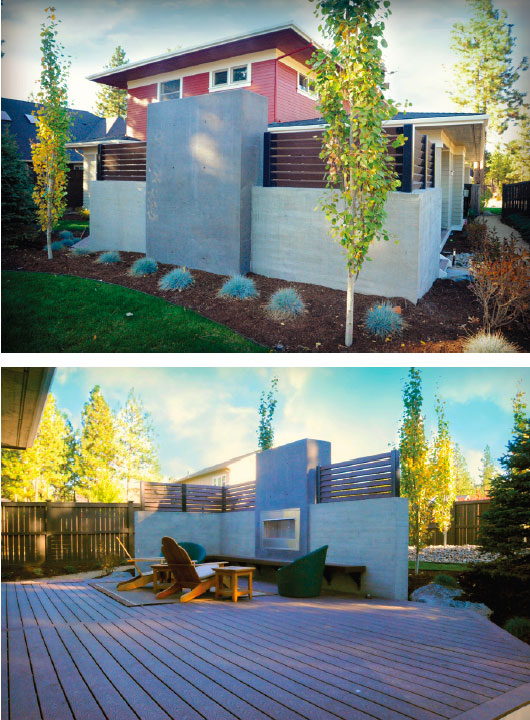
Safety: Fire and Lighting
Wildfires are inevitable in Central Oregon and Homeland’s landscape approach prioritizes fire safety. Oregon Senate Bill 762 was passed to help mitigate the damage of wildfires. With the new legislation, all landscapes have to adhere to certain guidelines. “Each neighborhood can make its own rules to a certain extent,” Becky explains. Clients can feel confident that Homeland will design compliant landscapes as well as beautiful ones, even in communities where there are not yet specific guidelines. “We’ll plan to remove existing trees with branches too close to the house as well as evergreens,” Becky says. “We’ll make sure your home’s environment is fire-safe if you’re on the edge of town up against the forest.”
As much as fire season is a part of living in Central Oregon, gathering around a fire pit or outdoor fireplace is also part of the lifestyle. In keeping with community guidelines, Homeland designs gas and sealed gas fireplaces that meet their clients’ desires and also are appropriate for the environment and particular site. In one outdoor fireplace project, Homeland’s work created much-needed privacy. “The existing residence sat lower than the surrounding homes,” Becky recalls. “Our client’s goal was to quickly block off those sight lines and regain privacy in their kitchen, living room, and bedroom.” To meet that goal, Homeland designed a concrete statement wall with two different finishes to create visual interest and also to provide additional height over the fireplace. They planted trees in the background to further enhance the space. Becky shares that as soon as the fireplace went in, the homeowners celebrated their reclaimed privacy.
Another aspect of Homeland’s work involves outdoor lighting design. “Lighting adds a touch of wonder to the landscape in the dark hours, adds safety to pathways, and makes the space feel customized to your lifestyle,” Becky explains. She typically offers clients several options to choose from that tie into the style of the home to bring cohesion to the overall look. “There are many amazing fixtures to choose from so I narrow it down to make it enjoyable and not overwhelming for the client to make selections. I love using wall lights, up lights on significant trees in the landscape, and path lights up the driveway and around walkways,” she says.
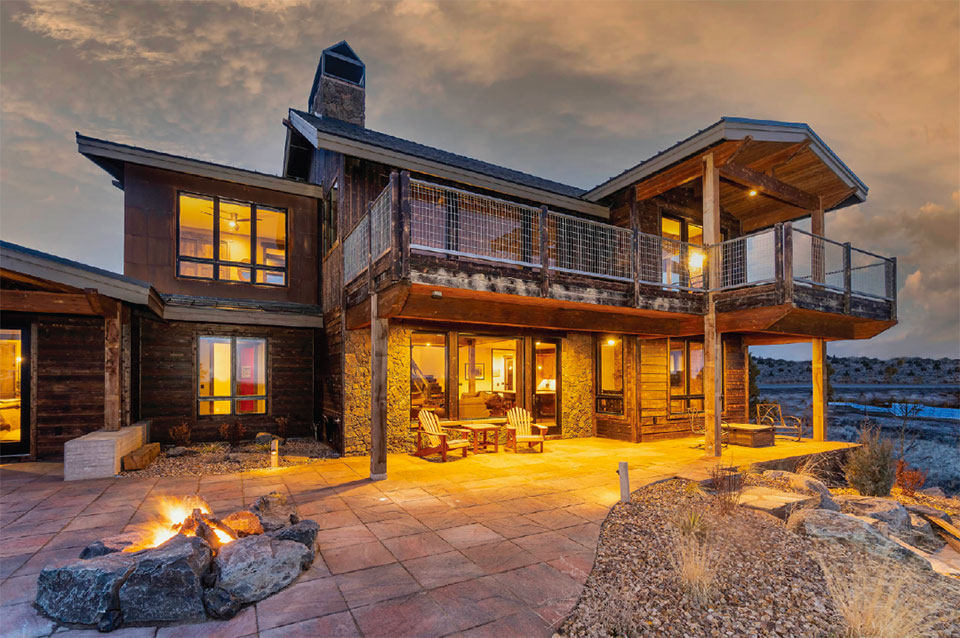
The Signature Service: Home and Landscape Design Together
Whether creating a smooth finish or a more casual and rugged boulder-bordered fire pit, Homeland’s features and outdoor patios flow. They are private and custom-tailored to their client’s goals. When they team up together for their signature home and site design services, Homeland’s work creates a strong indoor-outdoor connection of materials that were thoughtfully put together.
Becky and Joey shepherd clients through architectural review submittals, finding engineers, and acquiring permits. When working together, landscape design is woven into Homeland’s work in the early phases, which means clients have two designers looking at their projects the whole time. That teamwork enhances the outdoor living spaces and landscape, making a dream home a supportive holistic environment.
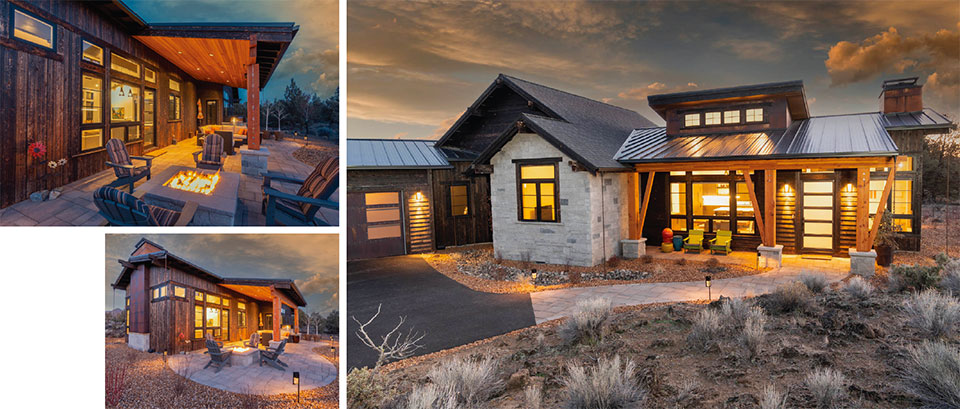
“Lighting adds a touch of wonder to the landscape in the dark hours, adds safety to pathways, and makes the space feel customized to your lifestyle.”
–Becky Shaw, Homeland Design
In a recent home that Homeland completed in Brasada Ranch, the client’s goal was to have a strong indoor-outdoor living experience. Joey situated the home on the lot around an existing rock outcropping. That choice allowed Becky to create a patio that looks out to the Cascade Mountains. “It’s a great place to enjoy the sunset and have a cocktail around the fire pit,” she shares.
Indeed, Homeland’s designs are inspired by the character of the property and by clients’ personal visions. They search for the best views, relevant topography features, and potential screening points. “Our goal is to gain a better understanding of why you bought your lot in the first place,” Becky says. Which, after all, is to enjoy the Central Oregon lifestyle.
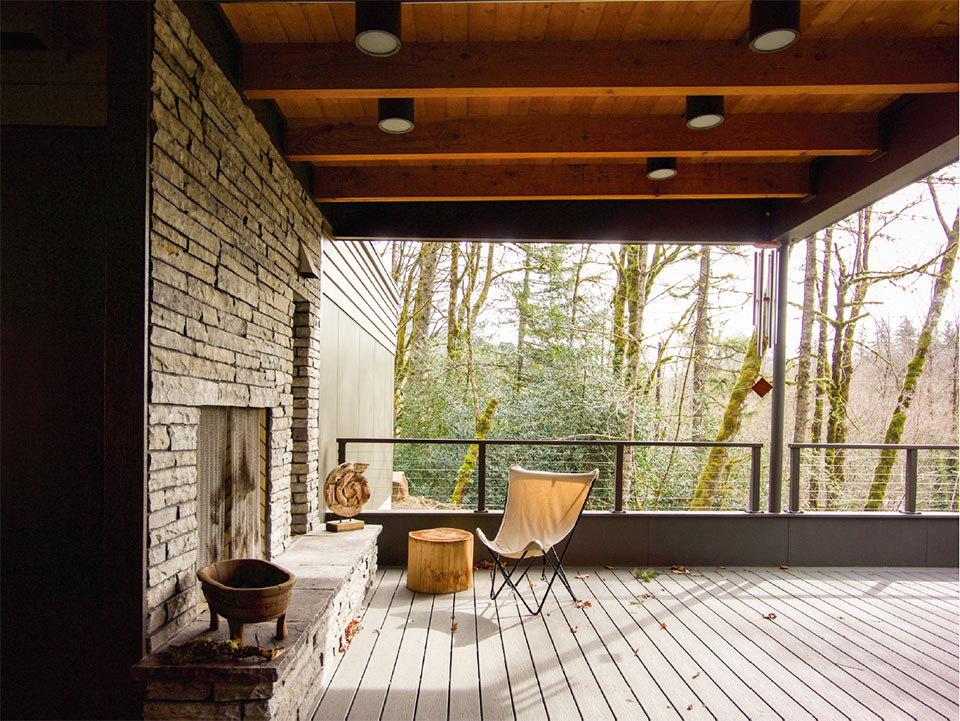
Going Out Back
Winsome Construction
Grilling with friends. Playing with kids and grandkids. Outdoor living spaces are meant to be fun. “Nobody goes outside to get stressed,” says Shan Stassens. Shan is a partner at Winsome Construction, a third-generation family-owned and -operated high-performance home builder providing custom residential construction in Oregon. With offices in Bend and Lake Oswego, Winsome has a breadth of experience serving clients across the state.
The company name speaks to Winsome’s desire to build top-quality homes that thoughtfully blend splendid structure, comfort, and beauty. The word winsome was formed from “wynn,” the Old English word for “joy” or “pleasure.” Things that are considered winsome are those that are attractive, charming, and delightful. With a sense of great joy for the trade, the company passionately pursues the creation of custom luxury homes that are truly “winsome.” This philosophy is seamlessly applied to their outdoor living spaces.
DESIGNING THE BACKYARD
Generally speaking, in Central Oregon a home cannot be designed without factoring in the outdoors. “Mountains, rivers, lakes – we’re just so active here,” Shan says. He notes that in Bend, people have a drink around the fire or smoke a cigar out back even when it’s 15 degrees outside. Understanding the Central Oregon way of life is inherent in Winsome’s process.
“When we look at designing a home in Central Oregon, we consider how living areas outside translate to the immediate surroundings of the home,” Shan explains. Clients will frequently choose a smaller house to allow for greater square footage of outdoor living space. These larger outdoor spaces merge the functionality of kitchens and living rooms with the benefits of fresh air and sunshine, all while providing a gathering space for friends and family.
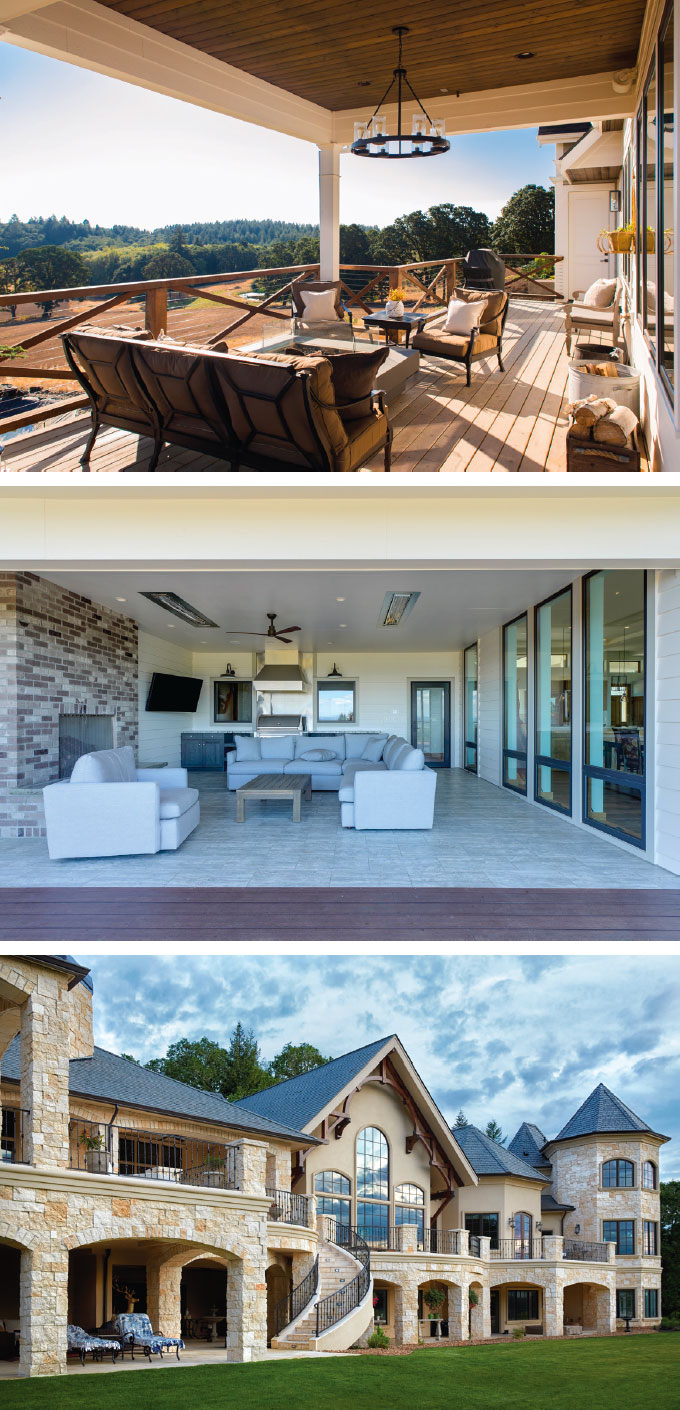
“When we look at designing a home in Central Oregon, we consider how living areas outside translate to the immediate surroundings of the home.”
–Shan Stassens, Winsome Construction
“Educating people about how a home’s outdoor spaces can be designed is one of our favorite parts of the work,” Shan says. For instance, Winsome enjoys planning herb and vegetable gardens that are easily accessible from the kitchen. Other Winsome services include designing and building outdoor fireplaces, fire pits, integrated smart spaces with TVs and audio, kitchens, offices, pools and hot tubs, and destination areas such as sport courts and workshops that require walking from the main house to a satellite location.
ENVIRONMENTAL IMPACT
A philosophy of sustainability permeates Winsome’s work. In addition to being an Energy Star and Earth Advantage certified residential builder, Winsome guides clients to streamline their designs for the best use of space. They encourage architects to eliminate duplicate spaces and incorporate features like exterior multi-slide doors in kitchens, living areas, and offices for a more integrated experience with the natural environment.
Winsome prioritizes the efficient use of natural resources. Landscape, hardscape, and irrigation are like frosting on the cake of a sustainable house. The company implements xeriscaping, low-flow sprinklers, and minimal yard lighting. It also uses reclaimed materials frequently, such as building retaining walls from native boulders and incorporating natural land benches into finished outdoor spaces.
The team at Winsome lives the company’s core values every day. Shan and his wife, Wendy, also a partner at Winsome, are currently building a new home in Central Oregon. Mindful material usage and joy-inspiring design elements are at the top of the list as they build. In addition to using bluestone, a natural material that will develop its own patina as it ages, their pergolas, decking, and wood features will be made from timber that Winsome repurposed from a project in Government Camp. Shan happened to be on the job site the day that trees on the site were being cleared, and learned they would be discarded to be cut into firewood. He stopped the process and had the trees cut into 20-foot lengths, hauled them to a sawmill and dried them, and will have one of Winsome’s wood framers install the beams. In addition to being cost-neutral, knowing the beams’ origin story and transformation adds a new layer of meaning and beauty to the home.
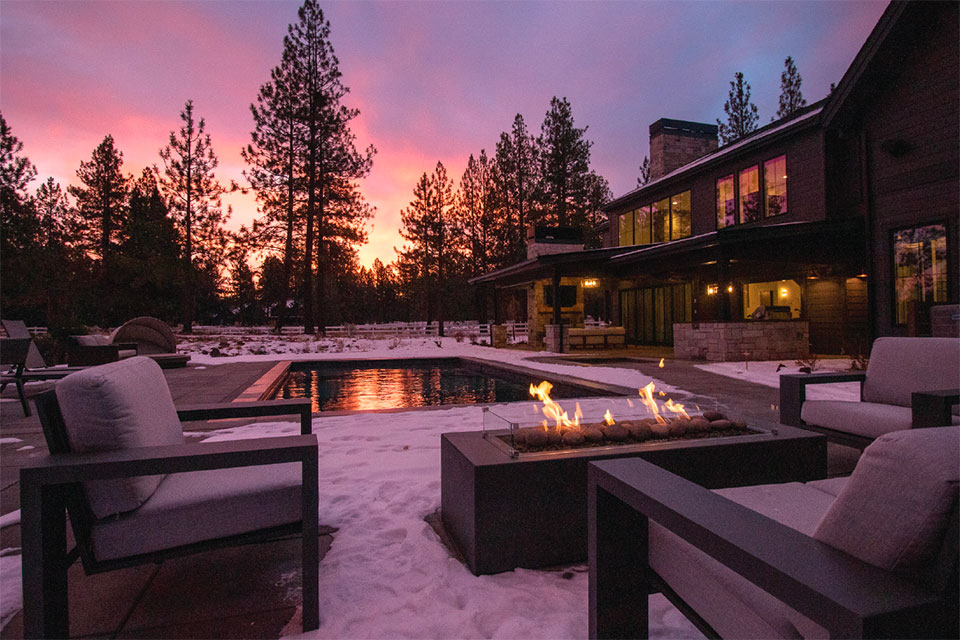
DESTINATIONS THAT WORK
“Anytime you can get kids outside enjoying trees and fresh air and using their bodies, there’s probably a very important direct impact from that experience,” Shan says. He recalls a time when Winsome built a treehouse for kids of all ages: “It was cedar-shingled and had a custom balcony, handmade doors, and windows,” he describes. “We built the base-level entry with a Dutch door so the kids could look out the top half. There was a pear tree next to it and the kids loved it. They came over all the time to play.”
Winsome creates outdoor destinations – places that might only be a 100-foot walk away from the main house – like a meditation space for a client who was Buddhist, or a yoga villa overlooking a custom-built lake featuring two staircases that led to the water’s edge. “We learn about our clients’ values and ideate ways to best implement them,” Shan says. “We guide people to put in things that make sense for their lifestyles and steer them away from things that don’t.” That approach means that clients’ budgets are preserved for the elements that truly bring joy to them. In the home with the yoga villa, Winsome recaptured rainwater and installed a burbling water feature, which became the soundtrack to the owner’s practice. “Everyone has a different dream for their outdoor living,” he adds.
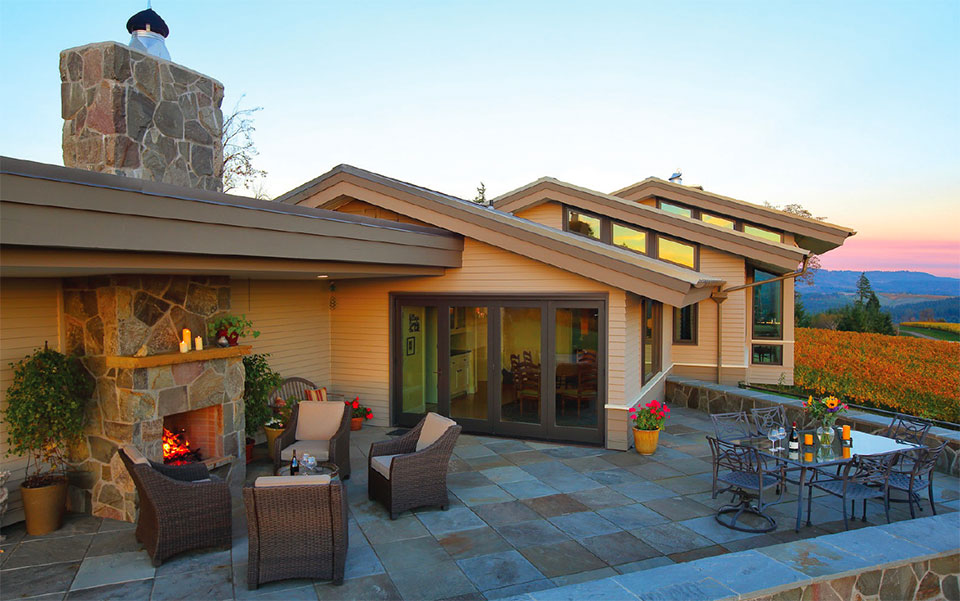
Shan recalls a recent home that Winsome designed for a family with young children. There were basketball and tennis courts, a golf simulator, and a trampoline that was built flush into the ground. The home also had fun outdoor features for the adults, including a pool and hot tub, fire pit, fireplace, TV, and integrated audio. Shan recalls that when the project was finished and the superintendent was doing a final run-through of the punch list at the end of the day, the homeowner came running around the side of the house in his board shorts to thank him for the outdoor space and to tell him how much they loved it. After they spoke for a minute, the homeowner went running back and did a cannonball into the pool where his kids were. Outdoor living exemplifies that spirit. “We think about what the end goal is for each client. The commonality is that their time at home, both indoors and outdoors, is meant to be enjoyable,” says Shan.
Designing an outdoor space with Winsome is enjoyable. “We love creating unique outdoor spaces and approach them with a sense of reverence,” Shan adds. “We live in a special place and are lucky to have the resources we have here.” That appreciation runs deep with Winsome. Shan shares how his family will use their outdoor living space, noting how lucky they are to have a view of the mountains. “I like to smell campfire wood and toast marshmallows. My wife and I really enjoy ornamental gardening and cultivating plants that produce fragrances, like honeysuckle or jasmine. I want our outdoor experience to be different than inside, but still comfortable. We love talking and having drinks on the back patio until the sun goes down. I enjoy watching the day end, reflecting on it, and being still,” he says. Whether it’s launching cannonballs into the pool with the kids or a quiet meditation as the day concludes, Winsome’s outdoor living spaces are joyful additions that enhance life in Central Oregon.
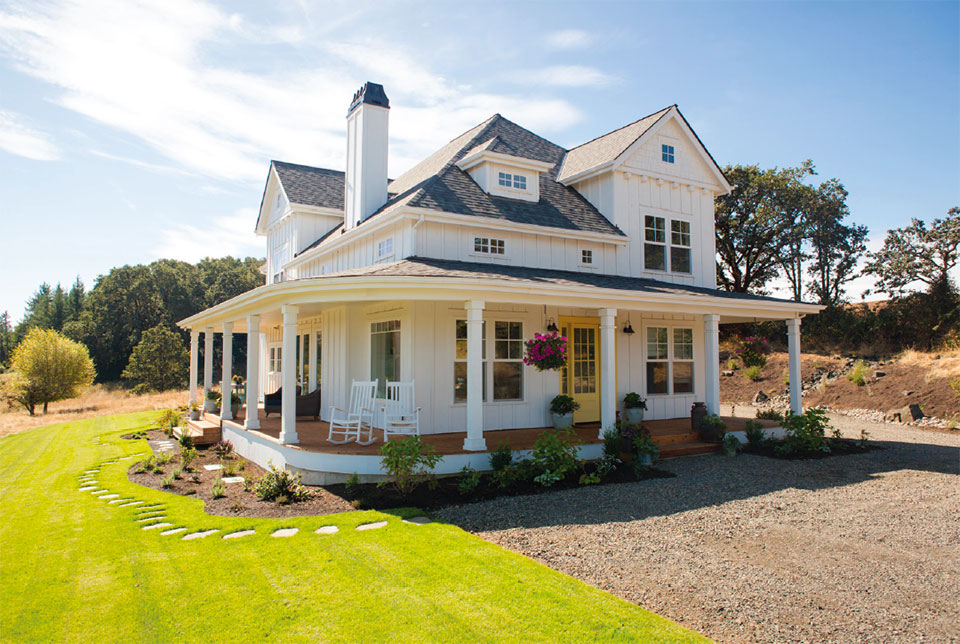
“We love creating unique outdoor spaces and approach them with a sense of reverencE. We live in a special place and are lucky to have the resources we have here.”
–Shan Stassens, Winsome Construction
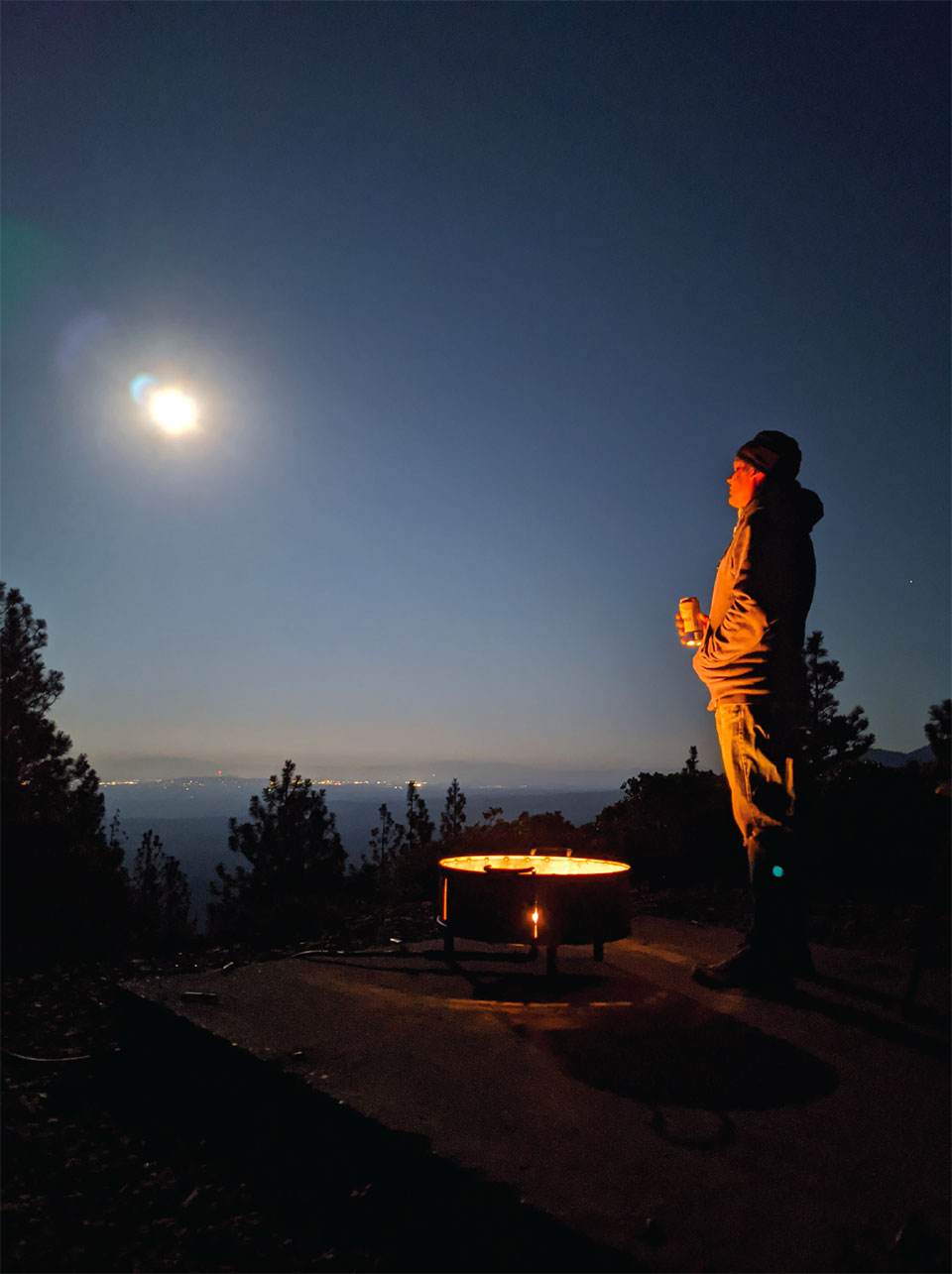
Heating Holding Hitting and Shaping
the Blacksmithing Studio of Orion Forge
“If you like to dance on tables, buy one from us.”
–Hunter Dahlberg, Orion Forge
“If you like to dance on tables, buy one from us,” says Hunter Dahlberg, who specializes in custom, hand-built ironwork. Hunter is the founder of Orion Forge, a blacksmith shop located in Bend that has been operating since 2004. Heating, holding, hitting, and shaping are part of their hand-forging process that produces functional one-of-a-kind work, like the sculptural white bark pine design of the corbel brackets surrounding the fireplace at Mt. Hood Meadows.
Orion Forge’s aesthetic ranges from heavily textured, traditional wrought iron to contemporary designs with clean lines. Their portfolio features barstools, tables, railings, grills, gates, and sculptures ranging from rustic to modern. Their fire pits, large-scale sculptures, and wall-mounted works enhance outdoor living areas and make bold statements that are influenced by Hunter’s independent spirit and love for the outdoors.
Hunter has a master’s degree in Outdoor Education. He spent years guiding month-long expedition adventures in Alaska, and he has taught kayaking and sailing. “Climbing a mountain is a luxury but you can learn important lessons along the way too,” he says. Although he found it rewarding to bring people out of their comfort zones and watch their transformations as they gained confidence in a new setting, he knew that he wanted to work outside the rigid framework of academia. Hunter’s choice to prioritize an outdoor lifestyle is articulated in Orion Forge’s name – Orion is his favorite constellation in the winter night sky.
HEATING
During the winter of 1995, Hunter was a ski bum living off-the-grid in New Mexico, high up in the Sangre de Cristo Mountains. While skiing, he stripped a binding. Friends told him to visit a guy named Les, a blacksmith who would have the tools to fix it. Hunter skied down to Les’s shop and was captivated from the moment he walked in. Hunter instantly recognized the autonomy Les had working for himself. The work of blacksmithing was alluring as well, and the two became friends.
When Hunter needed a job to support his skiing habit, Les put him to work. Thus began a journey into the art of blacksmithing. “When I first met Les, I thought I could never be a blacksmith,” Hunter shares. “But Les would say, ‘You just have to decide to be a smith. That’s when you start to become one.’ So I told myself, ‘I’m going to become one.’”
After a year working with Les, a friend in Bend invited Hunter to stay with him while he finished his thesis. Hunter brought his tools. He began making furniture, coat racks, and sculptures, and his work sold. Although he was still completing his degree, he recognized there was something in him that needed to work with his hands as a blacksmith. “Once you buy equipment for blacksmithing, it makes it hard to move,” he laughs. “You bolt it down to the floor and it’s heavy. So I stayed.”
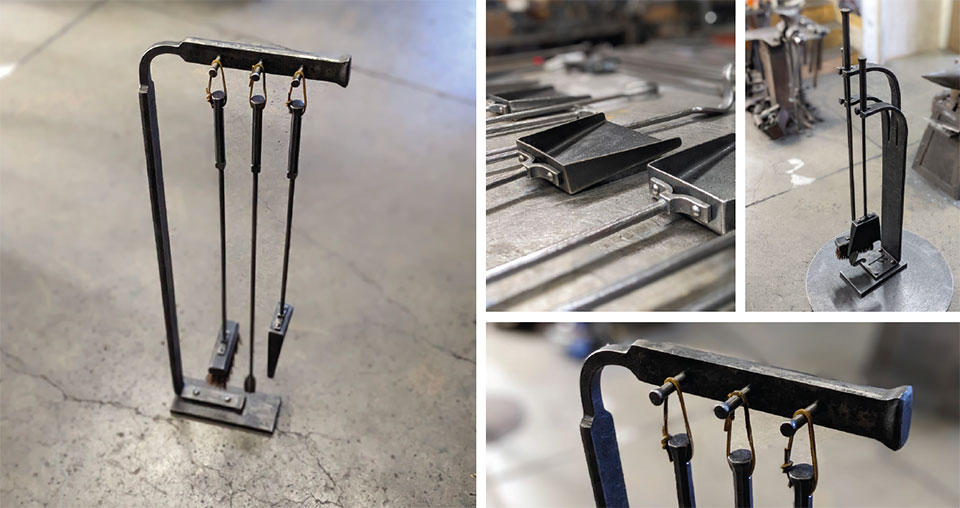
HOLDING
Some of Hunter’s favorite pieces to make are plancha cookers. “They’re fire pits with flat griddles on top,” he explains. They can be used as true wood-burning fire pits or as attractive appliances in outdoor kitchens. “Foodies put them in backyards with grills, smokers, and pizza ovens,” Hunter explains.
Orion Forge educates buyers on how to bring the planchas up to temperature so that meat and vegetables cook well on them, not to mention where to place them since they’re hard to move once installed. Like all of Orion Forge’s work, the plancha cookers are durable and withstand the elements. “We have clients who haven’t used theirs in months,” Hunter says. “All you have to do to tune it up is put a fire on, brush it, oil it, brush it again, and you’re ready. It stays seasoned like a cast iron pan and is an amazing way to cook.”
Robust fire pits are one of Orion Forge’s outdoor specialties. While Solo stoves are convenient and relatively durable, they don’t put out as much heat as Orion Forge’s fire pits. Solo stoves are trendy, making for a less-memorable experience than gathering around a custom, one-of-a-kind hand-forged work of art that can withstand 2,000 degrees.
“Because I am drawn to the history of blacksmithing, I am drawn to the traditional means of joining metal. I favor the older methods of joinery and use rivets or mortise and tenon techniques for prominent joints.”
–Hunter Dahlberg, Orion Forge
HITTING
“Because I am drawn to the history of blacksmithing, I am drawn to the traditional means of joining metal,” Hunter explains. “I favor the older methods of joinery and use rivets or mortise and tenon techniques for prominent joints.” The difference is clear. When looking at the pieces Orion Forge builds, there is a noticeable absence of visible welds that lends itself to an aesthetic that is of finely built ironwork. “It takes more time, but the results are obvious to the discerning customer,” Hunter adds.
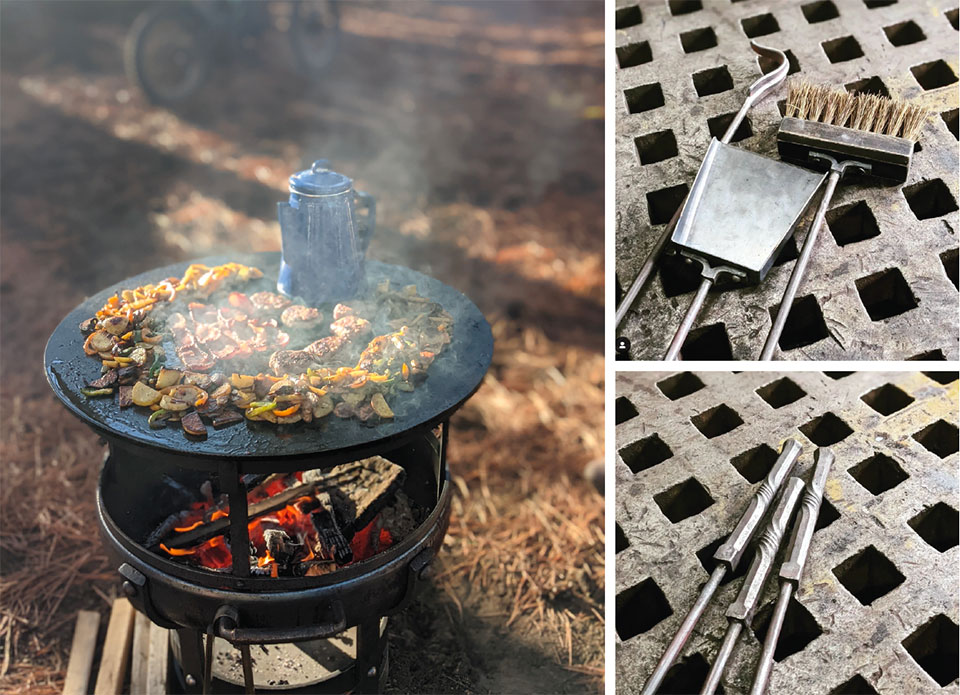
Many of Orion Forge’s tables are topped with barnwood, a genuine, re-used wood commonly found in central Oregon. “We do not purchase new wood and attempt to distress it to make it look old,” Hunter shares. “The character of hundred-year-old wood is impossible to mimic.” While wood is the preferred material because it adds warmth, Orion Forge also uses stone, glass, concrete, and steel. Because the furniture is unique and the process is fluid and organic, customers are encouraged to select the material that works best to achieve their design goals.
Hunter has also been developing a line of fire tools. The sets include a brush, shovel, and poker. With his crew at Orion Forge, Hunter has been exploring a range of stands from minimalist to more intricate. Recently he completed the Gandalf set, a rack that has a “G” in Elvin rune stamped on the base for a client whose last name started with a G. “The client wanted a G on it and liked the Lord of the Rings. We loved having the freedom to be creative,” Hunter shares.
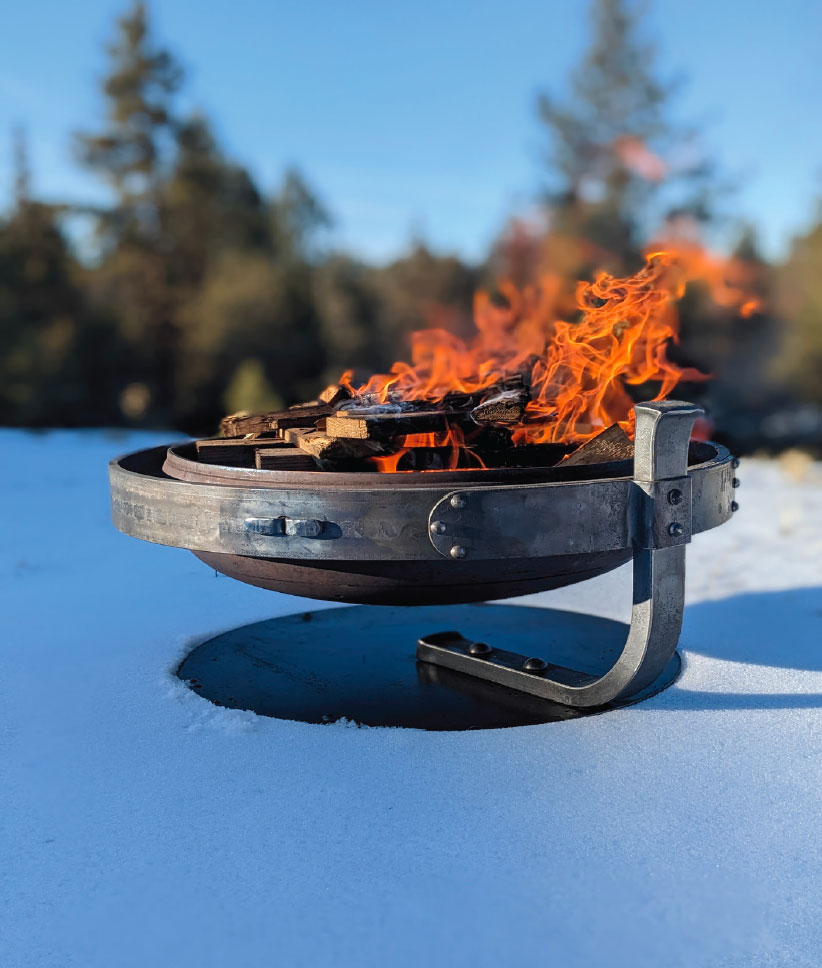
“Drilling 1,000 holes or welding 100 seams gets repetitive, but pulling a hot bar out of the fire and doing something with it has not worn off. I thought I was going to forge minds as a teacher, but bringing that hot material out of the fire and shaping it is what I love the most. It’s still exciting, every time.”
–Hunter Dahlberg, Orion Forge
SHAPING
Hunter is bringing it full-circle to his roots in education and offering custom, one-on-one classes that are fun and transformative. His favorite classes target young adults and teach life skills along with technical knowledge and require multiple sessions to complete. “There’s a lot of time to chat while we’re waiting for a bar to heat up or the saw to finish cutting, so we have ample opportunities to check in about school, home, life in general. The pride the students have upon finishing their pieces is palpable. They can’t quit staring at what they’ve built,” Hunter says.
Two particularly memorable students gave their pieces to their parents. He adds, “When they visit their parents’ houses they are reminded of their accomplishments. That sense of empowerment never goes away.”
Hunter retains the same level of enthusiasm for blacksmithing now that he did when he first walked into Les’s shop almost 30 years ago. “Drilling 1,000 holes or welding 100 seams gets repetitive, but pulling a hot bar out of the fire and doing something with it has not worn off. I thought I was going to forge minds as a teacher, but bringing that hot material out of the fire and shaping it is what I love the most,” he says. “It’s still exciting, every time.”
